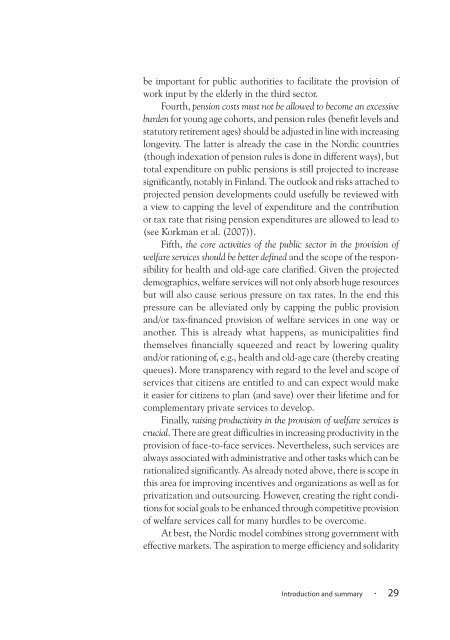The Nordic Model - Embracing globalization and sharing risks
The Nordic Model - Embracing globalization and sharing risks
The Nordic Model - Embracing globalization and sharing risks
Create successful ePaper yourself
Turn your PDF publications into a flip-book with our unique Google optimized e-Paper software.
e important for public authorities to facilitate the provision of<br />
work input by the elderly in the third sector.<br />
Fourth, pension costs must not be allowed to become an excessive<br />
burden for young age cohorts, <strong>and</strong> pension rules (benefit levels <strong>and</strong><br />
statutory retirement ages) should be adjusted in line with increasing<br />
longevity. <strong>The</strong> latter is already the case in the <strong>Nordic</strong> countries<br />
(though indexation of pension rules is done in different ways), but<br />
total expenditure on public pensions is still projected to increase<br />
significantly, notably in Finl<strong>and</strong>. <strong>The</strong> outlook <strong>and</strong> <strong>risks</strong> attached to<br />
projected pension developments could usefully be reviewed with<br />
a view to capping the level of expenditure <strong>and</strong> the contribution<br />
or tax rate that rising pension expenditures are allowed to lead to<br />
(see Korkman et al. (2007)).<br />
Fifth, the core activities of the public sector in the provision of<br />
welfare services should be better defined <strong>and</strong> the scope of the responsibility<br />
for health <strong>and</strong> old-age care clarified. Given the projected<br />
demographics, welfare services will not only absorb huge resources<br />
but will also cause serious pressure on tax rates. In the end this<br />
pressure can be alleviated only by capping the public provision<br />
<strong>and</strong>/or tax-financed provision of welfare services in one way or<br />
another. This is already what happens, as municipalities find<br />
themselves financially squeezed <strong>and</strong> react by lowering quality<br />
<strong>and</strong>/or rationing of, e.g., health <strong>and</strong> old-age care (thereby creating<br />
queues). More transparency with regard to the level <strong>and</strong> scope of<br />
services that citizens are entitled to <strong>and</strong> can expect would make<br />
it easier for citizens to plan (<strong>and</strong> save) over their lifetime <strong>and</strong> for<br />
complementary private services to develop.<br />
Finally, raising productivity in the provision of welfare services is<br />
crucial. <strong>The</strong>re are great difficulties in increasing productivity in the<br />
provision of face-to-face services. Nevertheless, such services are<br />
always associated with administrative <strong>and</strong> other tasks which can be<br />
rationalized significantly. As already noted above, there is scope in<br />
this area for improving incentives <strong>and</strong> organizations as well as for<br />
privatization <strong>and</strong> outsourcing. However, creating the right conditions<br />
for social goals to be enhanced through competitive provision<br />
of welfare services call for many hurdles to be overcome.<br />
At best, the <strong>Nordic</strong> model combines strong government with<br />
effective markets. <strong>The</strong> aspiration to merge efficiency <strong>and</strong> solidarity<br />
Introduction <strong>and</strong> summary · 29

















